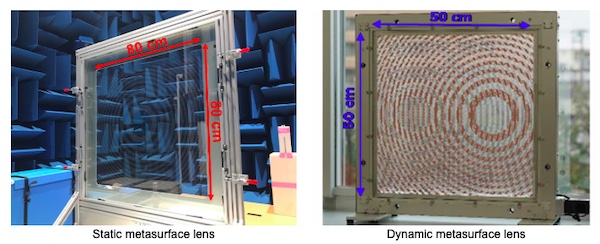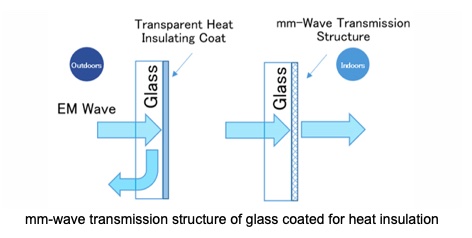DOCOMO and AGC Use Metasurface Lens to Enhance Radio Signal Reception Indoors
- New technology efficiently guides millimeter waves to target locations indoors
NTT DOCOMO, INC. and AGC Inc. announced that they have developed a prototype technology that efficiently guides 28-GHz 5G radio signals received from outdoors to specific locations indoors using a film-like metasurface lens that attaches to window surfaces. DOCOMO and AGC also conducted what is believed to be world’s first successful trial to direct 28-GHz signals passing through a window to specific locations indoors as well as raise the strength of the signals.
Newly emerging 5G networks as well as 6G networks of the future are expected to use high-frequency radio waves, such as 28 GHz. Although high-frequency signals enable the realization of advanced communication standards, they are subject to high attenuation over long distances and their high directivity resulting in low diffraction (or weak bending around objects) generally limits their range to within the line of sight of the transmitting base station. Consequently, it is difficult for high-frequency radio waves to penetrate windows, and even if they do they are attenuated to the point of not being able to propagate sufficiently to establish wireless communication links indoors.
Recommended AI News: ClearPoint Neuro Announces First Procedure Utilizing ClearPoint 2.0 Software
The new metasurface lens is made with an artificially engineered material featuring a large number of sub-wavelength unit cells arranged periodically on a two-dimensional surface. Elements arranged in various shapes on the metasurface substrate can be attached to a glass window to direct radio signals to specific points (focal points) indoors. It is believed that radio waves from an outdoor base station could be received on a window’s broad surface and then efficiently propagated to specific focal points inside a building with the help of repeaters and reflectors.
The metasurface lens material is a transparent film that can cover virtually the entire inside surface of a window. The material has no effect on LTE and sub-6 band radio waves, so it can be used to improve indoor reception of 28 GHz radio signals without affecting the performance of legacy wireless frequencies.
The trial confirmed that the metasurface lens improves the power level of 28 GHz radio signals received at indoor focal points. The trial also confirmed the ability to control focal-point position as well as the ability to switch from single to dual focal points.
Recommended AI News: AppsFlyer Appoints 20-year Technology Veteran as New Vice President for Sales for SEAPAC
In addition, DOCOMO and AGC verified that structural design technology can be deployed to enable metasurface lenses to allow high-frequency radio signals to penetrate glass that has been coated for heat insulation.
DOCOMO and AGC have been developing transparent metasurface technology for use in solutions that not only improve access to high-frequency radio signals but also are aesthetically acceptable. The new metasurface lens incorporates DOCOMO’s metasurface design technology and AGC’s design and microfabrication technologies.
The prototype metasurface lens will be presented during DOCOMO Open House 2021, which will take place online this February 4 to 7.
Going forward, DOCOMO and AGC will continue to collaborate in the research and development of technologies for highly efficient and flexible 5G and 6G wireless communication.
Recommended AI News: Ntooitive Digital Adds Four Sales and Partnership Veterans to Technology Team




Metal scrap market research Ferrous metal recycling fairs Iron salvaging solutions
Ferrous metal recovery facility, Iron scrap reforming, Metal waste reforming
Copper scrap processing efficiency Copper anode recycling Metal waste recovery yard
Copper cable refurbishment, Metal recycling and reusing solutions, Copper scrap sourcing